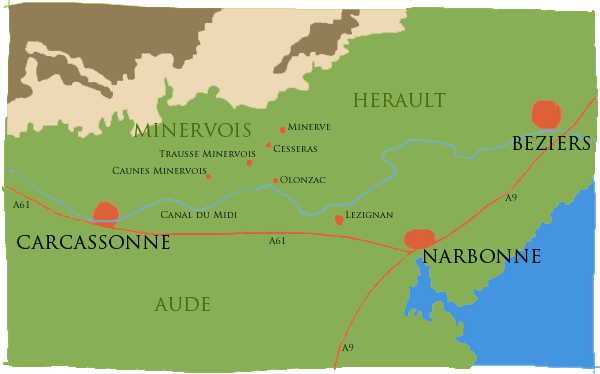A rich heritage in the heart of the French Minervois
Discover the rich history of the wine production in the Minervois
The human traces of the Minervois wines go very far back. Long before our reckoning, the cave man lived here. With the arrival of the Romans, the entire region is becoming interested in viticulture. The first plantations are done in the plains. The Haut Minervois will only develop later, under the influence of the monks. The Minervois has personally experienced the violence of Simon de Montfort and the Cathar Crusade. Minerve was a Cathar center and the siege of the city is a black page in the history of Occitania.

The vine arrived in the region of Agde with the Greeks in the 6th century BC. It was from Minerva that this whole region was Christianized by Saint Rusticus. The altar of white marble consecrated in 456 by this bishop of Narbonne remains the witness. Viticulture developed until the end of the Roman Empire, but subsequently declined.
Under the Carolingians, Minervois (Suburbium Minerbense) was a subdivision of Pagus Narbonensis. Because of its importance, in the ninth century, it became Pagus Minerbensis until the feudal era. During the Middle Ages monastic vineyards developed with the foundations of the abbeys of Lagrasse, Caunes-Minervois, Fontfroide and Saint-Hilaire. Monks improve viticulture.

When the heresy of the Cathars became dominant, there was no prohibition on wine unlike the Bogomiles and Manichaeans who included it in their dietary prohibitions. But during the crusade against the Albigensians, according to the Jesuit Langlois, partisan of the crusade, Henri de Beaujeu, “For three whole months, he occupied his troops to burn the wheat, tear the vineyards, cut the hedges and trees to bring down the houses, to ruin the roads, to make a desert of one of the most beautiful countries in the world. “
The Minervois was divided during the creation of the diocese of Saint-Pons in 1318 by John XXII, which means that the historic Minervois no longer adapts to the terroirs producing the Minervois appellation. During the Hundred Years War, the Black Prince advanced into the Languedoc and his passage ended in the uprooting of the vineyard.
In 1681 the completion by Pierre-Paul Riquet of the Royal Canal of Languedoc linking the Mediterranean Sea to the Atlantic Ocean allowed the installation of the modern vineyard. Like cereals, from the late eighteenth to the early nineteenth century, the wine was transported by barge. From 1855, the vineyard knew a strong progression. The powdery mildew crisis, followed by phylloxera, then the overproduction of lower quality wines spawned the revolt of 1907, which found its leaders in the Argeliers Committee.

During the economic expansion of the 18th century, the Canal du Midi in particular contributed. The canal was built by Pierre Paul Riquet and is now recognized by UNESCO as a World Heritage Site.
This AOC is located inland, north of the Narbonne and Carcassonne lines, with the Canal du Midi and the River Aude as the southern border, and the Montagne noir as the northern border. The region is located in two departments, the Hérault and the Aude. The area comprises 61 municipalities and is located at altitudes of 50 to 350 meters above sea level.
Of nearly 15 000 hectares of vines, of which 5 000 are destined for the production of AOC wines, the broad palette of vins de table, vins de pays and wines from single grape varieties is completed by three distinct AOCS:
- AOC Minervois
- La Livinière
- Muscat de Saint Jean de Minervois.
The AOC decreet
The winegrowers of the Minervois have been pursuing a policy of quality since the 1950’s and saw their efforts rewarded by obtaining an AOC-AOP in 1985.
61 municipalities were defined as permitted wine regions. The alcohol percentage must be at least 11.5% for the red and rosé wines and 11% for the white wines. The yield may yield a maximum of 48 hectoliters per hectare. The decree recognizes the AOC recognition for both red, rosé and white wines
The following grape varieties are permitted for red and rosé wines: syrah, mourvèdre, grenache lladoner pelut, carignan, cinsault, piquepoul, terret and aspiran.
The most important white grape varieties are grenache blanc, bourboulenc, marsanne, roussanne, macabeu and rolle. Picpoul, clairette and terret blanc are also permitted as secondary varieties.
The wines
The young red wines are elegant and well-structured, with aromas of black currants, violets, cinnamon and vanilla. As they mature, the aromas evolve into leather, candied fruit and plums. The tannins are silky, the aftertaste is long and full.
White wines smell of exotic fruits and flowers.
When making red wines, it is often stalked, traditionally vinified and, after alcoholic, also malolactic fermentation. In recent years, so-called red Minervois Noble wines have also been made with late harvest.
The saignée method is often used for rosé wines. These wines smell of small red fruits, cassis and raspberry.
The climate
A Mediterranean dominance with ocean influences in the western part (Clamoux and Côtes Noires). The part of the Causse above 200 meters has slightly harsh winters .
3 Appellations:
| Minervois An AOC since 1985 | La Livinière An AOC since 1999 | Saint Jean de Minervois An AOC since 1949 |
|---|---|---|
| 61 communes (16 in the Hérault et 45 in the Aude) | 6 communes (5 in the Hérault and 1 in the Aude) | 1 commune |
| Whites (3%), Rosés (13%) and Reds (84%) | Only reds | Saint Jean de Minervois |
| 130 000 hectolitres out of 3600 hectares in production | 9500 hectolitres out of 350 hectares in production | 6 000 hectolitres out of 215 hectares in production |
| Maximum yield permitted of 48 hectolitres per hectare | Maximum yield permitted of 45 hectolitres per hectare | Maximum yield permitted of 30 hectolitres per hectare |
| Principal red and rosé grape varieties : Syrah, Grenache, Carignan, Cinsault, Mourvèdre | Principal red grape varieties : Syrah, Grenache, Carignan, Cinsault, Mourvèdre et Picpoul | Single grape variety : Muscat Petit Grain |
| Principal white grape varieties : Grenache, Bourboulenc, Maccabeu, Marsanne, Roussanne | – | – |
| 177 independent wineries | 39 independent wineries | 6 independent wineries |
| 17 cooperative wineries | 2 cooperative wineries | 1 cooperative winery |
The terroirs
In their descent from the Montagne Noire to the Aude, the Clamoux, the Argent Double, the Ognon and the Cesse have created a series of terraces consisting of pebble, sandstone, schist or limestone. In the northwest, near Caunes-Minervois, veins of schist and pink marble can be found. The higher zones consist of Causses (karst areas), which are intersected with impressive gorges.
| Le Petit Causse (Cesseras = Le Petit Causse) |
| Stretching all the way along the piedmont of the Black Mountain, this zone benefits from an almost universal southern exposure. The temperature peaks are amongst the highest in the Minervois, and the rainfall amongst the lowest. A hot, dry, mediterranean sector ; here the viticulture of the slopes meets the garrigue. This zone often presents constraints for the vines, due to a lack of water supply. The eroded sandstone soils dominate this terroir, squeezed between the first limestone areas of the Causses and the stony quaternary-era terraces of the banks of the Ognon and Argent Double rivers. It is one of the most early-maturing and hottest zones of the Minervois. Wines there are often concentrated, warm and complex, characterised by aromas of stewed fruit. |
| Le Causse |
| This winegrowing zone is notable for its altitude, which ranges from 200m to nearly 500m. This results in the lowest night-time temperatures in the Minervois, and a slower thermal reheating in the spring. This zone’s semi-mountainous climate is also characterised by heavier and more regular rainfall than in the Minervois overall. The other important feature of this zone is the dominance of limestone soils, which can lead to a very stony surface. Whether the stone is hard or soft, the whiteness it lends the ground allows for indirect reheating of the plants and the grapes through radiation. Due to its altitude, this is among the latest of the Minervois zones to be harvested, and is characterised by a slow maturation. Out of the wines, which are often livelier than in the other zones, the aromatic range is marked by its freshness, and its mouth finish by tannins that can take two to three years to be softened. |
| Les Mourels |
| Caught between the limestone of Les Causses to the north and the Serre d’Oupia (a hill reaching a height of almost 300m) to the south, this sector is one of the hottest and driest in the Minervois. The mediterranean vegetation that develops on these hilly uplands only leaves space for the vine when there is sufficient depth of usable soil. Sandstone soils dominate in this terroir, varying in terms of erosion and depth. Visible on the side of the road or in the ditches, the banks of sandstone are impenetrable obstacles for the vine roots. Characterised by its slopes and foothills, this zone is one of the most precocious and hottest in the Minervois. The wines there are often concentrated, warm and complex, characterised by aromas of stewed fruit and blackcurrant. |
| The Balconies of the Aude |
| The whole winegrowing zone around the Canal du Midi, especially that part situated to the south / south-east of the Minervois, is the one that is the most influenced by the Mediterranean Sea (barely 30 km away as the crow flies). It is characterised by temperatures that are often higher than the average for the Minervois, with overall ranges tempered by the maritime influence. Rainfall is fairly well distributed over the course of the year, allowing regular nourishment for the vines. The soil types alternate between eroded sandstone of varying depth and stony quaternary-era terraces that allow varying degrees of filtrations. This is the the Minervois’ most precocious zone of (from 2 to 3 weeks ahead for the harvest compared to later sectors) and guarantees the rapid and regular ripening of the grapes. For grape varieties that need a lot of heat, like Mourvèdre. it is the zone of choice. |
| Les Terasses |
| Facing the Alaric Mountain, gateway to the Corbières, and overhanging the drained marshland of Marseillette, the central zone of the Minervois is the most temperate, as the Mediterranean and oceanic influences there are greatly reduced. The temperatures are quite high, even if the nights are a bit cooler than average, and there is little precipitation. It is a moderate, intermediary zone, allowing the vine to develop in optimal condtions. Here also, we find sandstone soils (of varying depths), which alternate wtih stony quaternary-era terraces. The specific area around Marseillette is composed of alluvial soils. It is one of the most temperate zones of the Minervois, where the excesses of the climate are felt the least. Thus, the wines are balanced and filled with great riches in the shape of tannins, polyphenols and anthocyanes (colour). |
Château Marcel has a rich history…
The history of Château Marcel
Château Marcel began modestly as a conglomeration of small houses built in the 9th century in the middle of the old mountain village of Cesseras that owes its name to the river Cesse that formed the beautiful gorges just behind the village.
The Cathars (also known as Cathari from the Greek Katharoi for “pure ones”) were a dualist medieval religious sect of Southern France which flourished in the 12th century CE and challenged the authority of the Catholic Church.
A rich heritage in the heart of the French Minervois…



